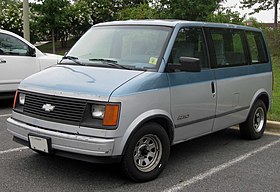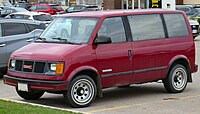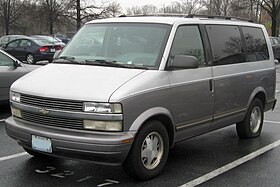
The Oldsmobile Silhouette is a minivan manufactured by General Motors for model years 1990–2004 over two generations.
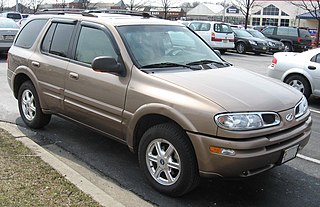
The Oldsmobile Bravada is a mid-size luxury SUV that was sold by Oldsmobile from 1991 to 2004. The only SUV ever marketed by Oldsmobile, the Bravada was the first light truck offered by General Motors outside of the Chevrolet and GMC divisions since 1924. The flagship of the GM midsize SUV line, the Bravada served as the most luxurious GM SUV prior to the introduction of the GMC Yukon Denali and Cadillac Escalade.

The Pontiac Trans Sport is a minivan marketed by the Pontiac division of General Motors over two generations for model years 1990-1999 along with GM badge engineered variants, the Chevrolet Lumina APV and Oldsmobile Silhouette.

The Chevrolet Express is a series of full-size vans produced by General Motors since 1996. The successor to the Chevrolet G-series van, the Express is produced in passenger and cargo variants. Alongside the standard van body, the line is offered as a cutaway van chassis; the latter vehicle is a chassis cab variant developed for commercial-grade applications, including ambulances, buses, motorhomes, and small trucks.

The Ford Aerostar is a range of vans that was manufactured by Ford from the 1986 to the 1997 model years. The first minivan produced by Ford, the model line was marketed against the Chevrolet Astro/GMC Safari and the first two generations of the Chrysler minivans. Introduced shortly before the Ford Taurus, the Aerostar derived its name from its slope-nosed "one-box" exterior.

The Chevrolet Lumina APV is a minivan that was produced by the Chevrolet division of General Motors. The first front-wheel drive minivan sold by Chevrolet, the Lumina APV was sold in a single generation from the 1990 to 1996 model years. Marketed alongside the Pontiac Trans Sport and Oldsmobile Silhouette, the Lumina APV competed against the Dodge Grand Caravan/Plymouth Grand Voyager, the extended-length Ford Aerostar, and the Mazda MPV.
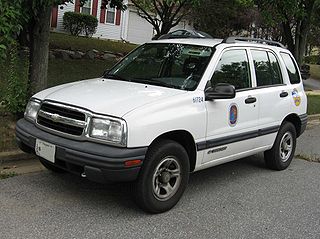
The Chevrolet Tracker, formerly the Geo Tracker, is a mini SUV produced for Chevrolet and Geo by CAMI Automotive in Ingersoll, Ontario. Although appearing as a compact SUV, the Tracker was actually certified as a light truck due to its off-road capabilities and body on frame construction. The Tracker was produced under many brands in several different editions and in many countries.
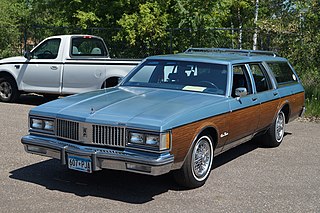
The Oldsmobile Custom Cruiser is an automobile that was manufactured and marketed by Oldsmobile from 1971 until 1992. Marking the return of Oldsmobile to the full-size station wagon segment, the Custom Cruiser was initially slotted above the intermediate Oldsmobile Vista Cruiser, ultimately above the later mid-size Oldsmobile Cutlass Cruiser.
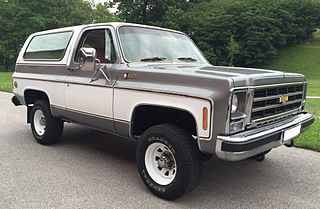
The Chevrolet K5 Blazer is a full-size sport-utility vehicle that was built by General Motors. Being GM's smallest full-size SUV, the K5 Blazer is part of the C/K truck series. Introduced to the Chevrolet line for the 1969 model year, the K5 Blazer was replaced for 1995 by the Chevrolet Tahoe. In 1970, GMC introduced its own model of the truck, called the Jimmy, which was discontinued in 1991 and replaced by the Yukon. The "Jimmy" name was chosen to reflect how GM may sound in a similar manner to how Jeep was thought to be a pronunciation of GP in the competing market. Both were short-wheelbase trucks and available with either rear- or four-wheel drive. Despite all Chevrolet versions from 1969 to 1988 having the "K5" badge, GM never internally referred to the model as the K5 Blazer/K5 Jimmy. Officially, the vehicles have always been referred to as the Blazer/Jimmy, without the K5 prefix. After the release of the S-Series Blazer/Jimmy in 1983, the models were officially renamed "Chevrolet Full-Size Blazer" and "GMC K-Jimmy", though they are often unofficially still addressed as "K5" to avoid confusion.
GMT is a nomenclature used by General Motors to designate multiple vehicle platforms. In use since the early 1980s, the GMT nomenclature is used for light trucks, full-size SUVs, and vans, along with several medium-duty trucks. With only a few exceptions, nearly all GMT vehicles use body-on-frame construction, along with rear-wheel drive powertrain configurations.
Turbo-Hydramatic or Turbo Hydra-Matic is the registered tradename for a family of automatic transmissions developed and produced by General Motors. These transmissions mate a three-element turbine torque converter to a Simpson planetary geartrain, providing three forward speeds plus reverse.

The Chevrolet (S-10) Blazer and its badge engineered GMC (S-15) Jimmy counterpart are compact/mid-size SUVs manufactured and marketed by Chevrolet and GMC from the 1983 through 2005 model years, over two generations – until the early 1990s alongside these brands' full-size SUVs with near identical nameplates, but lacking removable hardtops. From the 1992 model year, GMC's big Jimmy had become the 'Yukon', and so the S-15 prefix was dropped on the smaller GMC Jimmy. Starting with the 1995 second generation, the large Blazer was rebranded as the Chevrolet Tahoe, and these mid-size SUVs were simply launched as the 'all-new Chevrolet Blazer'.

The Pontiac Safari is a line of station wagons that was produced by Pontiac from 1955 to 1989. Initially introduced as the Pontiac counterpart of the two-door Chevrolet Nomad, the division adopted the nameplate across its full-size wagon range in 1957. Through its production, the Safari was positioned between Chevrolet full-size station wagons and below its Buick and Oldsmobile counterparts. During the mid-1960s, the Safari added simulated woodgrain trim to the exterior, becoming a feature associated with the model line.
Baltimore Assembly was a General Motors factory in Baltimore, Maryland. The plant opened in 1935 to produce Chevrolets and closed on May 13, 2005. It was a two-level plant located in the Canton Industrial Center to the east of the Inner Harbor, to the west of Dundalk, and south of Brewers Hill in Baltimore.
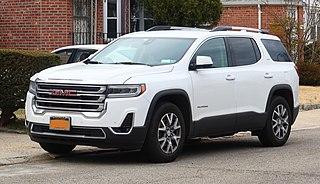
The GMC Acadia is a crossover SUV manufactured by General Motors for its GMC division. The first-generation GMC Acadia shared the GM Lambda platform with the Saturn Outlook, the Chevrolet Traverse, and the Buick Enclave. The Acadia went on sale in 2006 as a 2007 model in the United States, Canada and Mexico. The Acadia replaces three of the 7- or 8-seater vehicles on the Buick-Pontiac–GMC dealership network, the midsize GMC Safari van, the GMC Envoy, and the Pontiac Montana SV6 minivan for the domestic market. As of 2009, the Lambda vehicles have replaced the Buick Rainier, Buick Rendezvous, Buick Terraza, and the GMC Envoy XL and then subsequently the GMC Envoy, Chevrolet TrailBlazer and the Isuzu Ascender. A Denali version of the Acadia debuted for 2011. In 2017, the second generation Acadia was repositioned as a mid-size crossover utility vehicle in order to compete within the growing midsize SUV market against the likes of the Ford Explorer, Edge, and Jeep Grand Cherokee.
The 4L60E is a series of automatic transmissions from General Motors. Designed for longitudinal engine configurations, the series includes 4 forward gears and 1 reverse gear. The 4L60E is the electronically commanded evolution of the Turbo-Hydramatic 700R4, originally produced in 1982.

Chevrolet Nomad is a nameplate used by Chevrolet in North America from the 1950s to the 1970s, applied largely to station wagons. Three different Nomads were produced as a distinct model line, with Chevrolet subsequently using the name as a trim package.

GMT 360 is a vehicle platform that was manufactured by General Motors from the 2002 and 2009 model years. Designed primarily for SUVs, the GMT360 architecture served as the third generation of mid-size SUVs produced by GM. Directly succeeding its GMT330 predecessor in the United States, GMT360 vehicles based on the platform were sold with their predecessor in Canada and export markets through 2005.

The Chevrolet 90° V6 family of V6 engines began in 1978 with the Chevrolet 200 cu in (3.3 L) as the base engine for the all new 1978 Chevrolet Malibu. The original engine family was phased out in early 2014, with its final use as the 4.3 L (262 cu in) V6 engine used in Chevrolet and GMC trucks and vans. Its phaseout marks the end of an era of Chevrolet small-block engine designs dating back to the 1955 model year. A new Generation V 4.3 L (262 cu in) V6 variant entered production in late 2013, based on the LT1 small block V8 and first used in the 2014 Silverado/Sierra 1500 trucks.

The Chevrolet Van or Chevy Van is a range of vans that was manufactured by General Motors from the 1964 to 1996 model years. Introduced as the successor for the rear-engine Corvair Corvan/Greenbrier, the model line also replaced the panel van configuration of the Chevrolet Suburban. The vehicle was sold both in passenger van and cargo van configurations as well as a cutaway van chassis that served as the basis for a variety of custom applications.

